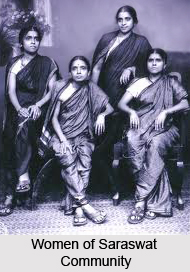 After the Maha-samadhi of guru, Swami Parijnanashram on Krishna Chaturdashi day of the month of Chaitra in 1720, His Holiness Shankarashram I was enacted as the second Guru of the Saraswats. At the Bhandikere Matha in Gokarn, the ceremony was held. It was for only 14 days when he was under Swami Parijnanashram and after that Swami Parijnanashram passed away. His devotees gave a grave promise in writing, that `they would be faithful to him and would always follow his religious observances`at the time of Swami Shankarashram`s ordinance as the new Mathadhipati. The Swami`s family henceforth was known as Shuklabhat Shukla. In Sanskrit it means "bright" or "new" and Bhat is a generic surname for scholars. So Shuklabhat means "New scholars".
After the Maha-samadhi of guru, Swami Parijnanashram on Krishna Chaturdashi day of the month of Chaitra in 1720, His Holiness Shankarashram I was enacted as the second Guru of the Saraswats. At the Bhandikere Matha in Gokarn, the ceremony was held. It was for only 14 days when he was under Swami Parijnanashram and after that Swami Parijnanashram passed away. His devotees gave a grave promise in writing, that `they would be faithful to him and would always follow his religious observances`at the time of Swami Shankarashram`s ordinance as the new Mathadhipati. The Swami`s family henceforth was known as Shuklabhat Shukla. In Sanskrit it means "bright" or "new" and Bhat is a generic surname for scholars. So Shuklabhat means "New scholars".
Thus swami Shankarashram I became the second guru of the Chitrapur Saraswats. After ordained in 1720, He served as the head till his Maha-samadhi in the year 1757. He is the man behind the establishment of the Chitrapur Math at Shirali that has became the head Matha of the Saraswat. The matha got, under his reign, many land grants from the King of Nagar. By a gift deed in the year1739, Basappa Nayak II of Nagar made land grants to the Math, which helped in the maturation of the infrastructure of the matha. Swami Shankarashram was the one who stimulated several people from stopping their Vaishnavite customs and convinced them to the Advaita Shaivism practised by the community.
Swamiji is believed to ascribe many miracles which he is said to have executed for his highly deeply religious followers when they were faced with difficulties. Two of which are:
A Brahmin in the village of Bankikodla used to offer hospitality to the needy people every morning after finishing his `pooja`, prayers and offerings to the Lord. Out of true concern for the people, he did this in need in his village. He has a great desire to serve Swamiji but was unable to travel long way to Gokarn to meet him. One day in the morning, he happened to see a sanyasi walking down his street, clad in saffron robes.
The brahmin discovered that it was none other than Swami Shankarashram. He led Swamiji to his house with great awe and fed him a simple meal that his wife had prepared. When Swamiji was resting after the meal, the Brahmin left his house for a while. On his return he could not find the Swamiji. He was very much disapointed that he could not see the swami off. Some time later when he went to matha on a call, he came to the truth that the swami had never left the matha at all that morning. With teary eyes the brahmin met Swami Shankarashram, and he fell at Swamiji`s feet and thanked him for having fulfilled his furthest desire. The devotion of many people grew day by day.
Swamiji started staying at the residence of the Nagarkatte family. The Nagarkatte family later in honour of the Swamiji donated their residence, after his death. This became the Chitrapur Math, the head matha of the community. Swami Shakarashram`s health failed rapidly during his stay at Shirali.
To the consternation of his devotees, Swamiji became terminally ill as his health took a turn for the worse. He said as translated, "My children, the grace of Lord Bhavanishankara will always protect you. Follow all that has been taught without fear".
With these words, on the 6th day of the month of Ashwina in 1757, Swami Shankarashram attained Maha-samadhi(passed away). His samadhi is located in Shirali and is also called the Hodi Samadhi.
Untimely death of Swamiji`s meant that he could not accept a shishya(disciple).









